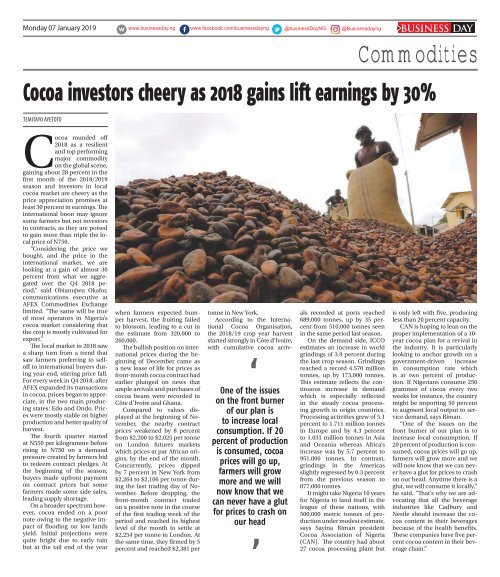BusinessDay 07 Jan 2019
You also want an ePaper? Increase the reach of your titles
YUMPU automatically turns print PDFs into web optimized ePapers that Google loves.
Monday <strong>07</strong> <strong>Jan</strong>uary <strong>2019</strong><br />
www.businessday.ng www.facebook.com/businessdayng @businessDayNG @Businessdayng<br />
BUSINESS DAY<br />
Cocoa investors cheery as 2018 gains lift earnings by 30%<br />
Temitayo Ayetoto<br />
Commodities<br />
Cocoa rounded off<br />
2018 as a resilient<br />
and top performing<br />
major commodity<br />
on the global scene,<br />
gaining about 28 percent in the<br />
first month of the 2018/<strong>2019</strong><br />
season and investors in local<br />
cocoa market are cheery as the<br />
price appreciation promises at<br />
least 30 percent in earnings. The<br />
international boon may ignore<br />
some farmers but not investors<br />
in contracts, as they are poised<br />
to gain more than triple the local<br />
price of N750.<br />
“Considering the price we<br />
bought, and the price in the<br />
international market, we are<br />
looking at a gain of almost 30<br />
percent from what we aggregated<br />
over the Q4 2018 period,”<br />
said Obianujwu Okafor,<br />
communications executive at<br />
AFEX Commodities Exchange<br />
limited. “The same will be true<br />
of most operators in Nigeria’s<br />
cocoa market considering that<br />
the crop is mostly cultivated for<br />
export.”<br />
The local market in 2018 saw<br />
a sharp turn from a trend that<br />
saw farmers preferring to selloff<br />
to international buyers during<br />
year end, stirring price fall.<br />
For every week in Q4 2018, after<br />
AFEX expanded its transactions<br />
in cocoa, prices began to appreciate,<br />
in the two main producing<br />
states: Edo and Ondo. Prices<br />
were mostly stable on higher<br />
production and better quality of<br />
harvest.<br />
The fourth quarter started<br />
at N550 per kilogramme before<br />
rising to N750 on a demand<br />
pressure created by farmers bid<br />
to redeem contract pledges. At<br />
the beginning of the season,<br />
buyers made upfront payment<br />
on contract prices but some<br />
farmers made some side sales,<br />
leading supply shortage.<br />
On a broader spectrum however,<br />
cocoa ended on a poor<br />
note owing to the negative impact<br />
of flooding on low lands<br />
yield. Initial projections were<br />
quite bright due to early rain<br />
but at the tail end of the year<br />
when farmers expected bumper<br />
harvest, the fruiting failed<br />
to blossom, leading to a cut in<br />
the estimate from 320,000 to<br />
260,000.<br />
The bullish position on international<br />
prices during the beginning<br />
of December came as<br />
a new lease of life for prices as<br />
front-month cocoa contract had<br />
earlier plunged on news that<br />
ample arrivals and purchases of<br />
cocoa beans were recorded in<br />
Côte d’Ivoire and Ghana.<br />
Compared to values displayed<br />
at the beginning of November,<br />
the nearby contract<br />
prices weakened by 8 percent<br />
from $2,200 to $2,025 per tonne<br />
on London futures markets<br />
which prices at par African origins,<br />
by the end of the month.<br />
Concurrently, prices dipped<br />
by 7 percent in New York from<br />
$2,264 to $2,106 per tonne during<br />
the last trading day of November.<br />
Before dropping, the<br />
front-month contract traded<br />
on a positive note in the course<br />
of the first trading week of the<br />
period and reached its highest<br />
level of the month to settle at<br />
$2,254 per tonne in London. At<br />
the same time, they firmed by 5<br />
percent and reached $2,381 per<br />
‘<br />
One of the issues<br />
on the front burner<br />
of our plan is<br />
to increase local<br />
consumption. If 20<br />
percent of production<br />
is consumed, cocoa<br />
prices will go up,<br />
farmers will grow<br />
more and we will<br />
now know that we<br />
can never have a glut<br />
for prices to crash on<br />
our head<br />
’<br />
tonne in New York.<br />
According to the International<br />
Cocoa Organisation,<br />
the 2018/19 crop year harvest<br />
started strongly in Côte d’Ivoire,<br />
with cumulative cocoa arrivals<br />
recorded at ports reached<br />
689,000 tonnes, up by 35 percent<br />
from 510,000 tonnes seen<br />
in the same period last season.<br />
On the demand side, ICCO<br />
estimates an increase in world<br />
grindings of 3.9 percent during<br />
the last crop season. Grindings<br />
reached a record 4.570 million<br />
tonnes, up by 173,000 tonnes.<br />
This estimate reflects the continuous<br />
increase in demand<br />
which is especially reflected<br />
in the steady cocoa processing<br />
growth in origin countries.<br />
Processing activities grew of 5.1<br />
percent to 1.711 million tonnes<br />
in Europe and by 4.3 percent<br />
to 1.031 million tonnes in Asia<br />
and Oceania whereas Africa’s<br />
increase was by 5.7 percent to<br />
951,000 tonnes. In contrast,<br />
grindings in the Americas<br />
slightly regressed by 0.3 percent<br />
from the previous season to<br />
877,000 tonnes.<br />
It might take Nigeria 10 years<br />
for Nigeria to land itself in the<br />
league of these nations, with<br />
500,000 metric tonnes of production<br />
under modest estimate,<br />
says Sayina Riman president<br />
Cocoa Association of Nigeria<br />
(CAN). The country had about<br />
27 cocoa processing plant but<br />
is only left with five, producing<br />
less than 20 percent capacity.<br />
CAN is hoping to lean on the<br />
proper implementation of a 10-<br />
year cocoa plan for a revival in<br />
the industry. It is particularly<br />
looking to anchor growth on a<br />
government-driven increase<br />
in consumption rate which<br />
is at two percent of production.<br />
If Nigerians consume 250<br />
grammes of cocoa every two<br />
weeks for instance, the country<br />
might be importing 50 percent<br />
to augment local output to service<br />
demand, says Riman.<br />
“One of the issues on the<br />
front burner of our plan is to<br />
increase local consumption. If<br />
20 percent of production is consumed,<br />
cocoa prices will go up,<br />
farmers will grow more and we<br />
will now know that we can never<br />
have a glut for prices to crash<br />
on our head. Anytime there is a<br />
glut, we will consume it locally,”<br />
he said. “That’s why we are advocating<br />
that all the beverage<br />
industries like Cadbury and<br />
Nestle should increase the cocoa<br />
content in their beverages<br />
because of the health benefits.<br />
These companies have five percent<br />
cocoa content in their beverage<br />
chain.”

















